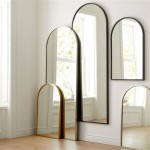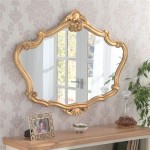```html
TV in a Mirror: Exploring the Reality-Reflecting Technology
The integration of television technology within mirrors presents a fascinating convergence of functionality and aesthetics. This innovation transforms a commonplace household object into a multifaceted device, offering entertainment, information, and a touch of futuristic elegance. “TV in a Mirror” refers to displays seamlessly embedded within or behind a reflective surface, rendering them invisible when inactive and revealing themselves as a television screen when powered on. This technology leverages advancements in display manufacturing, optical engineering, and concealing techniques to achieve this dual-purpose functionality.
The core appeal of TV in a Mirror lies in its space-saving and visually appealing design. Traditional televisions often dominate a room's aesthetic, particularly in smaller spaces. By integrating the television into a mirror, this technology minimizes visual clutter and offers a clean, minimalist appearance. The mirror can function as intended when the television is off, providing a practical and decorative element. When desired, the television can be activated, seamlessly appearing within the reflective surface. This dual functionality makes it desirable for bathrooms, bedrooms, living rooms, and even commercial spaces like hotels and gyms.
The realization of TV in a Mirror involves a complex interplay of technological components and manufacturing processes. It necessitates the use of specialized display panels, optical films, and mirroring technologies to achieve the desired effect. The integration process must consider factors such as light transmission, reflection properties, and the overall durability of the combined mirror-television system.
Key Point 1: The Technology Behind the Illusion
Several key technologies contribute to the creation of a TV in a Mirror. These include:
Specialized Display Panels: The display panels used in these systems are often LCD or OLED variants, chosen for their slim profile and ability to produce vibrant images. The key characteristic is their enhanced light transmission capabilities, allowing the image to be visible through the reflective layer. Some manufacturers utilize modified or custom-designed panels to optimize performance and minimize image distortion when viewed through the mirror.
Dielectric Mirror Coatings: The mirror effect is achieved using a dielectric mirror coating applied to a glass substrate. This coating is a thin film composed of multiple layers of dielectric materials, each with a carefully controlled refractive index and thickness. These layers are designed to selectively reflect certain wavelengths of light (creating the mirror effect) while allowing others to pass through (allowing the display image to be seen). The specific composition and layering of the dielectric materials are crucial for achieving the desired balance between reflectivity and transparency.
Optical Bonding and Lamination: To ensure optimal image clarity and durability, the display panel and the mirror glass are often bonded together using optical bonding techniques. This process involves filling the gap between the panel and the glass with a transparent adhesive that has a refractive index closely matched to the glass and the panel. This minimizes internal reflections and refractions, resulting in a clearer and brighter image. Lamination techniques may also be used to further enhance the structural integrity and prevent shattering in case of impact.
Backlighting Systems: The backlight system is essential for illuminating the display panel and ensuring sufficient brightness for the image to be visible through the mirror. LED backlights are commonly used due to their energy efficiency, long lifespan, and ability to produce a bright and uniform light source. The design of the backlight system must minimize light leakage and ensure that the light is directed primarily towards the viewer, preventing unwanted reflections or glare.
Control Systems and Connectivity: Like a standard television, TV in a Mirror incorporates control systems for adjusting brightness, contrast, volume, and other settings. These systems are typically controlled via remote control or on-screen menus. Connectivity options such as HDMI, USB, and Wi-Fi are also included, allowing users to connect external devices and access streaming services.
Key Point 2: Applications and Use Cases
The versatility of TV in a Mirror technology makes it suitable for a wide range of applications across various sectors. Some prominent use cases include:
Residential Spaces: In homes, TV in a Mirror can be integrated into bathrooms, bedrooms, and living rooms. In bathrooms, it offers a convenient way to watch news or entertainment while getting ready. In bedrooms, it can be incorporated into dressers or vanity mirrors, providing a seamless blend of functionality and aesthetics. In living rooms, it can be used as a decorative mirror that transforms into a television when needed, minimizing visual clutter.
Hospitality Industry: Hotels can use TV in a Mirror to enhance the guest experience. Integrating the technology into bathroom mirrors or dresser mirrors can provide entertainment and information without sacrificing space or aesthetics. This can be a differentiating factor that elevates the hotel's perceived value and attract discerning guests. It also provides a way to communicate hotel information and promotions directly to the guest.
Retail Environments: Retail stores can use TV in a Mirror to create interactive displays and enhance the shopping experience. By integrating the technology into fitting room mirrors, customers can view product information, browse related items, or even take virtual photos. This can create a more engaging and informative shopping experience, potentially leading to increased sales.
Commercial Spaces: Offices, gyms, and other commercial spaces can utilize TV in a Mirror for various purposes. In offices, it can be used in meeting rooms or reception areas to display presentations or company information. In gyms, it can be integrated into workout mirrors to provide instructional videos or entertainment. In other commercial settings, it can be used to display advertisements or announcements in a visually appealing manner.
Healthcare Facilities: Hospitals and clinics can use TV in a Mirror to entertain and inform patients. Integrating the technology into patient room mirrors can provide a distraction during long stays and provide access to educational resources about their condition and treatment options. This can improve patient satisfaction and promote better health outcomes.
Key Point 3: Challenges and Future Trends
While TV in a Mirror technology offers numerous benefits, it also faces certain challenges that need to be addressed for wider adoption. These include:
Cost: The manufacturing process and specialized components used in TV in a Mirror systems contribute to a relatively high cost compared to traditional televisions. As the technology matures and production volumes increase, the cost is expected to decrease, making it more accessible to a wider range of consumers.
Image Quality: Achieving optimal image quality through a mirror can be challenging due to factors such as light transmission loss and potential image distortion. Ongoing research and development efforts are focused on improving display panel technology, optical coatings, and bonding techniques to enhance image clarity, brightness, and color accuracy.
Mirror Reflectivity: Balancing the reflectivity of the mirror with the transparency required for the display to be visible is a critical design consideration. The reflectivity needs to be high enough to provide a clear and functional mirror, while the transparency needs to be sufficient to allow the display image to be seen without significant attenuation. Achieving this balance requires precise control over the composition and layering of the dielectric mirror coating.
Viewing Angles: The viewing angles of TV in a Mirror systems can be limited compared to traditional televisions. This is due to the reflective nature of the mirror surface and the potential for glare or reflections from ambient light sources. Future developments may focus on improving the viewing angle performance through the use of wider viewing angle display panels and anti-glare coatings.
Future Trends: The future of TV in a Mirror technology is likely to be shaped by several key trends, including:
Integration with Smart Home Systems: As smart home technology becomes more prevalent, TV in a Mirror systems are expected to be increasingly integrated with smart home platforms. This will allow users to control the television, adjust settings, and access other smart home devices through voice commands or mobile apps.
Augmented Reality (AR) Applications: The integration of AR technology into TV in a Mirror systems could open up new possibilities for interactive experiences. For example, users could use the mirror to virtually try on clothes, visualize furniture in their home, or access real-time information overlaid on their reflection.
Improved Image Quality and Energy Efficiency: Ongoing advancements in display panel technology are expected to lead to significant improvements in image quality, brightness, and energy efficiency. This will result in TV in a Mirror systems that offer a more immersive and energy-saving viewing experience.
Customization and Personalization: Future TV in a Mirror systems are likely to offer greater customization options, allowing users to tailor the appearance and functionality of the technology to their specific needs and preferences. This could include options for choosing different mirror finishes, frame styles, and display sizes.
In conclusion, TV in a Mirror represents a compelling fusion of technology and design, offering a unique blend of functionality and aesthetics. As the technology continues to evolve and mature, it is poised to become an increasingly common feature in homes, hotels, retail stores, and other commercial spaces. The ongoing innovations in display technology, optical coatings, and smart home integration will further enhance the capabilities and appeal of this reality-reflecting technology.
```
How To Make A Mirror Tv Step By Instructions

6 X Vanityvision Mirror Sample Television

Mirror Tv How It Works Joseph Mccarthy Mirrors

Eclipse Tv Cover By Electric Mirror Tvc 43 Emr615297

Tv Mirror Mirrorworld

Disappearing Act Séura S Tv Mirrors Amaze Wolfers Lighting

Frame Less Android Smart Mirror With Built In Tv At Bathselect

70 Framed Samsung Mirror Tv Television

Mirrorvue Mirror Tv Evervue Usa Inc

Buy Tv Mirror Framed 75 Inch With Ornate Options








